Modulations through time
Playing with the Goldbergs
Stephen Emmerson and Bernard Lanskey
Introduction
This article attempts to chart the process of evolution, both compositionally and performatively, which culminated in a specific individualised performance at the Unfolding the Process symposium in Oslo in November 2015. This particular performance realisation was itself a variation of a series of performances of Bach’s Goldberg Variations given by the two authors in various manifestations for two pianos.
The overt form of this article appears as a presentation of two discrete perspectives. In terms of the ‘voicing’ of each perspective, the first belongs to Stephen, speaking as the advocate and principal ‘arranger’, while the second to Bernard adopting the role also of respondent. As in our performances where two keyboards articulate a shared presentation, we hope that adopting an illusion of two perspectives offers a way of articulating our complex mix of ideas more coherently and transparently. But, as with any duo (Piano 1 and Piano 2), the true integration is of course much more complex than the artificial separation might appear on the surface.
The first perspective outlines the unfolding process whereby a new formal conception of the work was developed. This arrangement of an arrangement evolved over time through significant interaction between the two players into a final score designed for the specific performance discussed here. The second perspective reflects more on the performative and philosophical dimensions of the performance experience itself, both in real time and subsequently.
Perspective 1A (Stephen Emmerson): Background and Context
Many artistic research projects unfold over an extended period of time. Though in music they are often initially directed towards a single performance outcome, perhaps the most interesting ones we have been involved with continue to develop in multiple fruitful directions that were unanticipated at earlier stages. Often led by serendipitous circumstances and even determined in part by pragmatic matters, it is deeply satisfying to experience how the nature of the music-making can transform by responding to emerging contexts and new collaborators. Such was the case with the project discussed below.
This paper examines one recent stage of a project that has been developing on and off since 2012 when I arranged Bach’s Goldberg Variations for two pianos for a performance with Sonya Lifschitz at Four Winds Festival in Bermagui, New South Wales. I subsequently performed it with Sonya in a number of different contexts over the next few years. Moreover, presentations on various aspects of the arrangement were made in conferences in Australia, Singapore and Cambridge.[1] The underlying rationale and nature of the arrangement, together with some discussion of issues of interpretation, has been outlined in a paper written in 2014 but not published until some years later (Emmerson, 2017).
A new phase of the project began when I came to play it with my friend and colleague Bernard Lanskey. We have been playing duos together on and off for many years, an ongoing musical partnership challenged primarily by the geographical circumstances of living in different countries. In early 2015 we had the opportunity to play it at the Mathemusical Conversations Symposium in Singapore. Unsurprisingly, playing the work with a different musician immediately changed how I played it, indeed, even how I conceived it. Collaboration is now widely recognised as a key stimulator of creative practice (Cook, 2018) and so, inevitably, a different chamber music partner brings a different sound and temperament - not to mention differing rehearsal strategies and concepts of Bach playing – which, in turn, invite a creative response. Enabling a spontaneous musical dialogue to emerge from within a solo work had always been central to the concept of the arrangement and so the new conversations with Bernard – both musical and verbal - were welcome and deeply stimulating. Moreover the particular performance context within a symposium that focussed on intersections between mathematics and music encouraged us to view the interpretation of the work in a totally new light. That in turn led to invitation to present keynote at Unfolding the Process in Oslo in November 2015 for which a different form of the work was developed.
Originally our intention for Oslo was to rework the Singapore presentation from earlier in the year. However, in the intervening months, we had co-authored a paper that both analysed and reflected on the Singapore performance (Lanskey & Emmerson, 2016). It was evident that our perspective had moved so far in that time that the Oslo presentation would need to be very different if it was to reflect our current ideas.
Perspective 2A (Bernard Lanskey): Questions raised in preparing for and responding to the 'Singapore project.'
Of the various aspects discussed in that co-authored paper, a notable factor was the relationship between abstract structure and the perception of the work’s shape in performance. Some dimensions of this deserve summarising here as they form an essential backdrop to compositional and performative dimensions involved in this ‘Oslo project.’
The ingenious structure of Bach’s Goldberg Variations has long been recognised, with its 32 pieces built around its series of nine canons at successively expanding intervals. In abstract, the structure as it is commonly described (and represented in the right-hand columns in Figure 2) makes it look impressively orderly, balanced and symmetrical. However the complex relationship between that structure and its embodiment in real-time performance has rarely been interrogated in any depth. The shape of the work in performance differs in obvious matters such as the fact that, though most variations are 32 bars long, their radically different tempi means that such neat abstract representation does not at all reflect the experience of time across the work – neither in the objective measurement of durations nor the subjective perception of the work’s shape. Further, those relationships cannot help but be substantially different from performance to performance – in ways that are far from trivial - depending on the tempi and relationships between them employed by different performers. These tempi relationships have been explored to some extent by others (Schenkman, 1975 and Martens 2004), especially since Gould’s 1981 recording where he deliberately designed close arithmetical relationships between the metronome markings of successive variations. As Schenkman wrote in 1975:
a decision made with regard to the tempo of any given variation immediately sets up the conditions for a definite relationship to be realized between that variation and those that surround it. In fact, it is the nature of the inner relationships thus established that ultimately determines the total character of the work in its performance. (p. 3)
The full implications of this statement have rarely been explored since. Following the Singapore performance, we found ourselves considering, ever more subtly, the spaces between successive variations, a crucial set of decisions that every performer of the work has had to consider consciously or subconsciously. We had decided that we would not predetermine either the tempi relationships not the spaces between variations in either the Singapore or Oslo performances as we were determined that such matters, among others, would be judged spontaneously in response to the context[2]. However the recording of the Singapore performance enabled the decisions we made in performance to be analysed and it was revealing to see how they related to, and indeed underlined, the structural divisions in the abstract representation in Figure 1. (Lanskey & Emmerson, 2016). Having realised the performative importance of this dimension, the relative lack of consideration of this in performance studies literature is notable.
As the newcomer to the project, my second point of significance, one that also seems little explored in performance literature, is the sense of freedom which emerges in being involved for the first time in a collaborative realisation of an iconic solo work. If on one level, the sense of daring involved in manipulating or adding to such well-known material was creatively exciting (see excerpt from Variation 1in Figure 1), on another level, the licence to play with it even when performing the authentic material when masked by completely new additions was extremely liberating, particularly when experienced so early in a full performance of the whole piece.
The emergent performative approach, with ‘playing-with-time’ and of ‘playing-with-material’ in the interpretative foreground, evoked a dialogue which evolved, at a meta-level, into license for some of the decisions taken for the subsequent performance in Oslo.
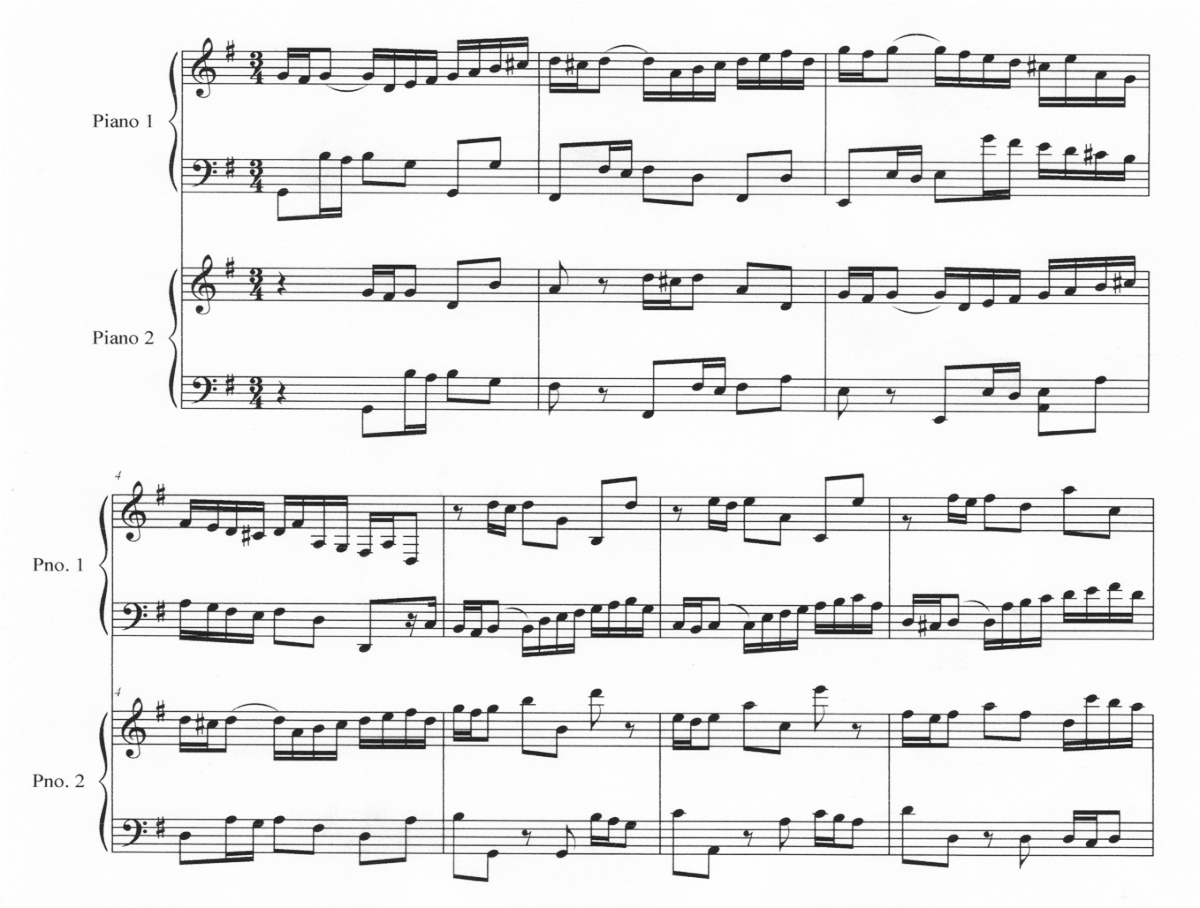
Figure 1. J. S. Bach Goldberg Variations (Arr. Emmerson), Variation 1, bars 1-7
Perspective 1B (Stephen Emmerson): Rationale
In the schedule of the Oslo symposium we were allocated two successive 35-minute sessions, one for performance and the other for discussion. Given that our performance of the work in Singapore had taken over 50 minutes (that is, without repeats), we could not play the whole piece, unless we ran over into the following session which would have left us very little time to discuss our approach. Alternatively we could have just played a selection of individual variations - ones that illustrated some issues we wanted to discuss – but we were loath to do that. The Goldberg Variations as a whole is much more than sum of the parts and we wanted to offer and then reflect upon the holistic experience of an extended work as its structure unfolds through time. So, to adapt to the new context, we decided to develop a shorter version of the work, one that would be as close to 30 minutes as possible. While, obviously this could be done in a range of ways, we were keen to develop a version which had a structural coherence, balance and logic comparable to the original. Moreover we wanted to explore an idea I had been considering for some time, of transposing some of the variations to provide a tonal structure.
The work is perfectly successful with all the variations in G as Bach wrote them. In fact Charles Rosen has even referred to it as “the most successful of all his [i.e. Bach’s] works in concert performance today” (2012, p. 217) and, one might add, probably on CD as well. Why would one contemplate interfering with the composer’s form – both the number of variations and their keys - when it works so well? On the other hand, one might ask whether one should be forbidden to experiment with alternatives even in a successful work. Jeremy Denk (2012) has identified several of what he calls the work’s “fatal flaws”, the first of which being “Too much G major.” He writes “No amount of artistry and inspiration … can make you forget that you are hearing 80 minutes of G major; it’s like trying not to notice Mount Everest.” (See here) As is obvious from his title, his comments were tongue-in-cheek of course but I felt that there may be an underlying point that warranted some more serious consideration.
The issue relates to the nature of the work itself: whether it was conceived as a work for performance as a complete whole or whether, like the Art of Fugue, Musical Offering, even the Well Tempered Clavier, the publication was offered as a systematically organised compendium of pieces, intended more as a treatise for private study and contemplation than a work for public performance. Bach himself arranged for it to be published in 1741 under the title Clavier-Übung (Keyboard Practice/Exercise) offered to “Denen Liebhabern zur Gemüths-Ergetzung verfertiget” (“for music-lovers for the refreshment of their spirits”). In a sense, it might be viewed as the inverse of the Well Tempered Clavier that covers every key (twice) whereas here all the pieces are in the key of G with only three of the 32 offering some tonal contrast by being in the minor mode.[3] Such a prolonged maintenance of a single key begs the question whether Bach would have envisaged them to be performed as a complete set (even if the solo public recital had existed at that time). As with the Well Tempered Clavier - or sets such as the Chopin or Debussy Preludes for that matter - the common practice of performing them all in a concert is a distinctly modern one. Hans Keller, back in 1964, even suggested that the Goldberg Variations be considered as “a collection of variations from which suitable ones might be chosen according to the performer’s mood (the earliest example precedent for a whole class of contemporary ‘indeterminate’ pieces, in fact).” (p. 110) If Bach didn’t intend all the variations necessarily to be performed in turn, there is a case to present a carefully considered and well-designed selection.
The Goldberg Variations offer a wide range of expressive characters and affects. Having such a range expressed in the same key seems at odds with the 18th century’s highly developed sense of key characteristics. Steblin (2002) has collected extensive evidence of how specifically musicians, composers and theorists of the 18th (and 19th) centuries associated individual keys with very specific affects. Those in the Goldberg Variations extend way beyond those that would be associated with G major and minor. I was particularly conscious of this issue with another project I had been developing that connected and juxtaposed pieces from different composers from 18th and 19th centuries that shared the same key.[4] However, in that case, despite the various different shades, it was the commonalities that were evident between pieces that shared the same key and their descriptions across time that was most striking. 18th century sets of variations traditionally had all variations in the same key but the Goldberg Variations are the longest work for solo keyboard in the 18th century. As such, its extended timescale raises an issue that doesn’t arise elsewhere in variations from that period.[5]
The next set of variations of comparable dimensions in the western canon is Beethoven’s Diabelli Variations. Though predominantly in C major, notably Beethoven does provides a pillar of tonal contrast by following three variations in C minor (nos. 29-31) by the extended fugue in E flat major. The disarmingly beautiful effect of the final Tempo di Menutto variation owes much to the return to C major. But I was also aware of Beethoven Variations Opus 34 (1802) which has a very systematic tonal structure of descending thirds and, from a later period, Brahms Variations on a theme of Schumann Opus 23 (1861), a work Bernard and I have performed and recorded. Both these provide successful models for having variations in different keys to provide variety and build a satisfying tonal structure.
As alluded to above, many of the variations suggest affects of keys other than G major. For example the pastoral quality of Variation 24 suggested F major to me more than G. I recall the striking moment when I first played no. 25 in F# minor and it “felt so right” that, from that moment, the idea of building a tonal structure across the work was irresistible.[6] The other Variation in a minor key, no. 15, by contrast, seems to me to have a distinctly F minor character.[7] The three variations that Bach wrote in minor key are subtly but also essentially different in character. When we played them in g minor in earlier performances with both Sonya and Bernard, we had explicitly explored how they could be distinguished in terms of affect, mood and tempo. But once the idea of transposing them into different keys was embraced, this seemed such a palpable way to underline their differences and thereby add another dimension to their individual qualities.
I am aware of course that to some still today taking such liberties might be considered as a form of heresy or sacrilege. In response one might refer to the range of emerging approaches that argue for the concept of experimentation[8] to replace that of interpretation. In such approaches “the performance of past musical works is not regarded in its reiterative, reconstructive, or reproductive function. This new practice instead insists on performance as a locus of experimentation” (D’Errico, 2018, p. 7). Our intentions involved no disrespect to the original but encouraged experimentation as stimulus for finding new ways of hearing and playing it. As such, our approach aligns with a creative paradigm rather than recreative one (Cook, 2018).
So, having decided to explore this idea, the performance in Oslo presented a double challenge: firstly to decide on keys that would reflect the affects of individual variations and then, secondly, to build these into a coherent, convincing and satisfying tonal structure. We welcomed the challenge of designing a structure whose underlying logic and balance would be comparable to Bach’s example.
Perspective 1C (Stephen Emmerson): Designing a new structure
Before getting to the questions of transpositions, the first matter to decide was how many pieces we could fit into a 30-minute version. However many that was to be, we felt it needed to be a number with some of the mathematical symbolism comparable to Bach’s original.[9] It was also clear to us that, given the structural counterpoint as shown in Figure 2, the chosen number should allow a layered structure of comparable sophistication and elegance. In fact, beyond having 32 pieces (2x2x2x2x2), Bach’s published structure can also be seen as 30 variations that are framed by the Aria at both ends. Those 30 variations can be viewed simultaneously as two groups of 15 variations or three groups of 10. 15, in turn can be seen as five (i.e. 2+3) groups of three variations. Figure 2 below sets out these divisions in arithmetic terms. However, as Williams (2001) underlines, there is a marked distinction between how the work’s shape is conceived in the abstract and how it is perceived in performance. To mention just one example, Bach’s positioning of a canon each third variation is not as easily audible as the table might suggest.
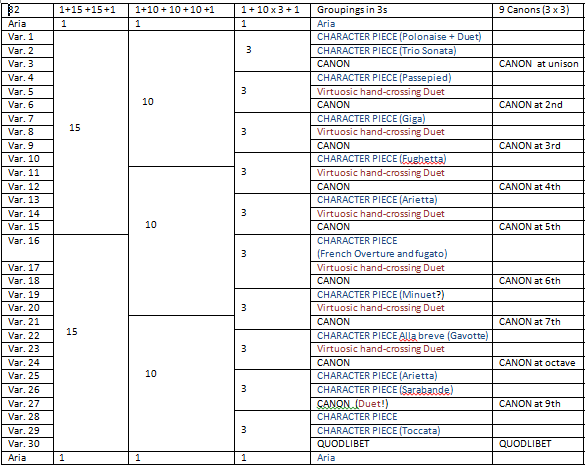
Which other numbers would allow comparable structural counterpoint? As alternatives we considered 26 (which is both 1 + (4x3) + (4x3) + 1 and 1 + 8 + 8 + 8 + 1) and 22 (1+ (10x2) +1) but, even if choosing variations of shorter duration, they both would have been too long. We also considered 20 (1 + 9 + 9 + 1 and 1 + (3x3) + (3x3) + 1). In the end 18 was decided on as the best option partly because its potential subdivisions into units divisible both by 2 and 3 (1 + 8 + 8 + 1 and 3x3 + 3x3) together with the realisation that that any more than that would probably exceed the available time and not meet the central challenge we had set ourselves.
The structure thus conceived is shown in Figure 3 below.

Figure 3. The arithmetic structure of a proposed shortened Goldberg Variations.
Given that so many variations were to be cut, the question arose of how much the shape of the familiar work - its identity even - should, or could, be retained. A case could be made for both retaining some clear relationship to the familiar form of the work or, alternatively, for a more radical reordering. As our first reworking, we opted for the former on this occasion. To retain much of the original sense of identity, a fairly obvious solution was to keep the nine canons plus Quodlibet to provide the spine and to have that structure framed by the opening and closing Arias. In the original there is one canon in each group of three variations. In this version there would be two. But that only left room for six other variations to be included. How should they be chosen?

Figure 4. The structure of the shortened Goldberg Variations retaining the Arias, canons and Quodlibet.
In my arrangement the canons are closest to being transcriptions – that is, Bach’s notes were distributed between the two pianos without any additional lines.[10] The two variations where I had added most additional lines were the first variation and penultimate one (Variation 29), that is, immediately before the final Quodlibet. So the symmetry of keeping those two in the new version appealed and was retained. To establish the tonic key at both ends, they (plus the Quodlibet) were all kept in G major. But, with that decision made, there was only room for four more variations to be included. We had some tough decisions to make.
I then started to consider which key(s) might suit each of the canons and, then, whether they could follow each other in the proposed structure. If they didn’t, then some other variation could be inserted to link them, hopefully convincingly. In choosing the remaining variations, we needed to balance which ones we’d like to include with which ones would link well into the structure set by the backbone of the structure provided by the canons. The ones we ultimately chose to insert are set out below in Figure 5.
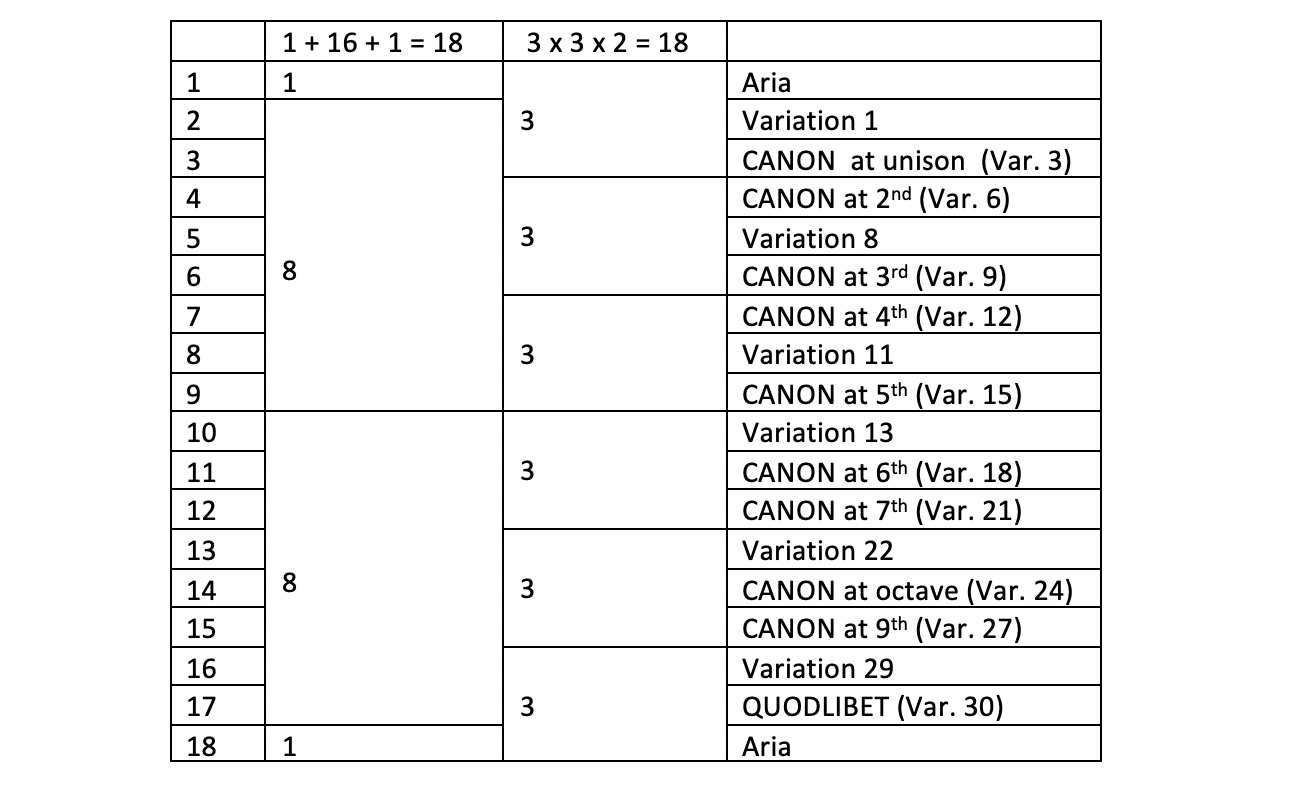
Figure 5. The structure of the shortened Goldberg Variations
The choices involved some regrettable omissions. It is difficult to imagine a form of the Goldberg Variations without no. 25 – the one Landowska dubbed “the black pearl”. The decision was not taken lightly. To quote from an email I sent to Bernard on 28 September:
I suppose the biggest omission [from the proposed plan] is no 25 - the big G minor one that is hard to leave out except that it is by far the longest variation (4 and a half minutes) so [it] is hard to justify [its inclusion] if the aim is to reduce the overall time. Also two of the canons are in minor keys so I think minor keys are represented enough on balance. Personally I LOVE Var.15 in F minor and Var.21 in F# minor - they feel absolutely right to me! And we do keep in the other exceptionally expressive one (no. 13) which I also think works beautifully in A flat major especially following no.15 in F minor.
The initial key scheme I proposed in that email is below. As was noted in the email, there were some nice symmetries in that plan. As I wrote in that email, “More to the flat side in the first half and more to the sharp side on the way back. As you can see, many of the progressions are either 3rds or 5ths so I think should flow/connect nicely.” In particular the third relationships may recall Beethoven’s Opus 34 and Brahms’ Opus 23. In truth, I was wanting to emulate the glorious move from E flat minor into B major between the 4th and 5th of Brahms’ variations in this set. In fact, that moment, perhaps more than any other, may have been the inspiration for adopting this approach to the Bach.
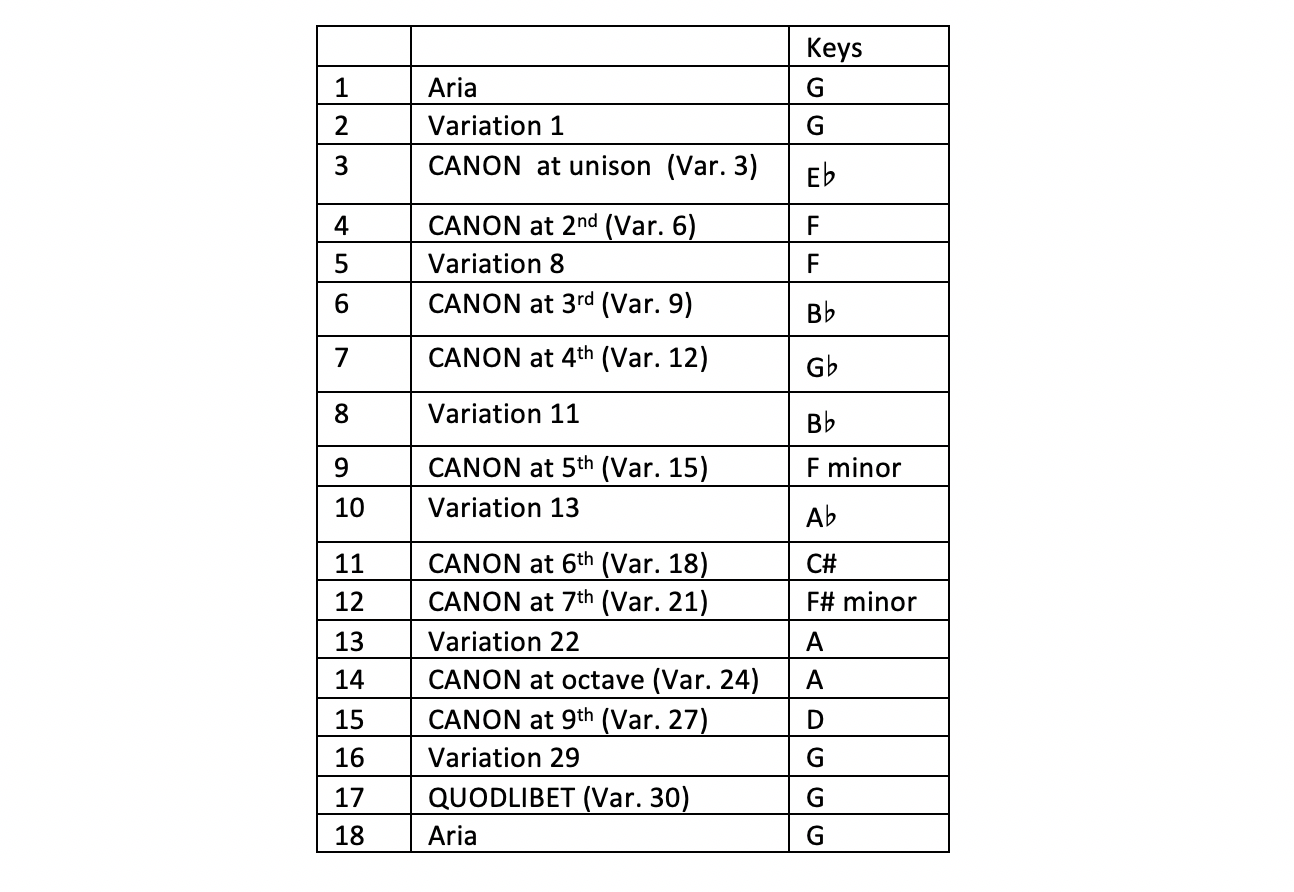
Figure 6. The initial key scheme proposed.
The available transpositions were limited mostly to keys within a scale step or two – at most three – from the tonic. It was surprising to us how raising or lowering the pitches even a few steps changes the textures on pianos to a degree we found unacceptable. The most distant key in terms of scale steps from the tonic was the D major for the canon at 9th. This was a variation that I had arranged in multiple versions, the latest of which also involved dislocations of octave registers (and chirpy grace notes) that gave it a playful character intentionally verging on the grotesque. So having it start on a tonic so far from G and then continuing to jump octave registers disturbed the impression less than it would have in other variations.
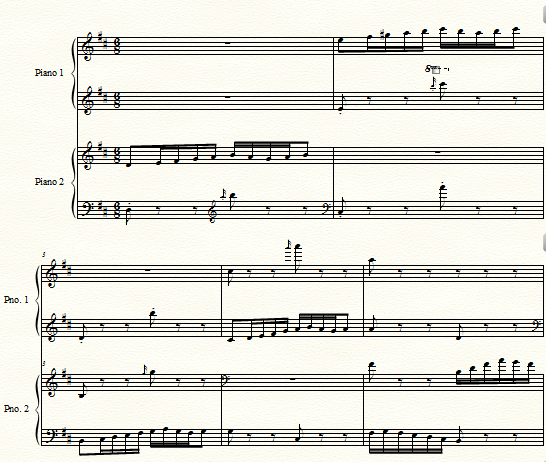
Perspective 2B (Bernard Lanskey): Evaluating the new structure
As the last few email quotes demonstrate more specifically, I had been involved in the arranging process at least philosophically before the chance arrived to try our thoughts in rehearsal. Of course, Stephen had been living with the work – and the various possibilities described above – at a much deeper level and with a far greater investment of time.
In preparation for the weekend of rehearsals Stephen had produced a file that gave the last bars and opening bars of each variation – clearly the links between the variations and judging the spaces between them was going to be crucial. My first reaction, before working with Stephen, was that the original plan was perhaps too extreme in moving away from an original where everything had been in the same key: in particular, it seemed to me that some of the keys were too far removed in terms of conventional tonal relationships to be organically persuasive. We therefore entered our only rehearsal period (on a weekend few weeks before Oslo) with multiple potential tonal possibilities still in contention, including keeping them all in G.
When we did play them through on Saturday many of the key changes seemed to work very well in characterising the music on an individual level but I remained concerned that the large-scale architecture was in fact being undermined by so many continual changes of key. There seemed too many shocks – in fact the opposite problem from being too much in one key. Having decided by the end of the rehearsal to revert them all to the key of G, the next morning found us both with some residual sense of disappointment that the idea of transposing had been dropped. In particular, early on in the subsequent rehearsal when we came to Variation 3 we suddenly missed the common tone modulation from the previous day whereby the tonic of G became the third of E flat major. (See Figure 8.) Also in reverting to material previously experienced, we found ourselves missing the (arguably very baroque) sense of adventure which comes with performing transpositions!
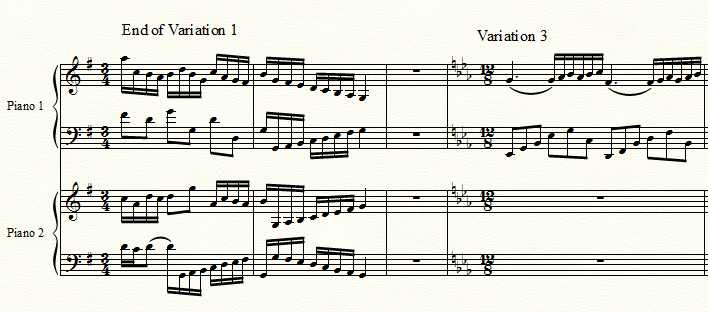
Perspective 1D (Stephen Emmerson): The final form and a new Quodlibet.
In response to Bernard’s concerns, we considered whether a successful compromise could be developed whereby we kept some transpositions but had fewer key changes by having groups of consecutive variations in a shared (and related) key. The new scheme we developed is shown in Figure 9 below. The canon at the 4th was kept in B flat major so there was a group of three variations in that key. It had worked beautifully in G flat major on the foreground level but, we felt this would be preferable from a larger perspective. Initially pieces 9-16 had gone to the very distant keys of F minor, C# major and F# minor and then returned gradually via relative keys and circle of 5ths to G by the last three pieces. (i.e. A flat/G# - C# - f#, then A – D – G). Again, that had a certain logic to it but, in terms of the overall form, G major returned late and we felt that the tonic should be re-established earlier. The affect of the Variation 21 in F# minor had to be sacrificed but we agreed that – at least for this occasion – the overall tonal structure was now more convincing.
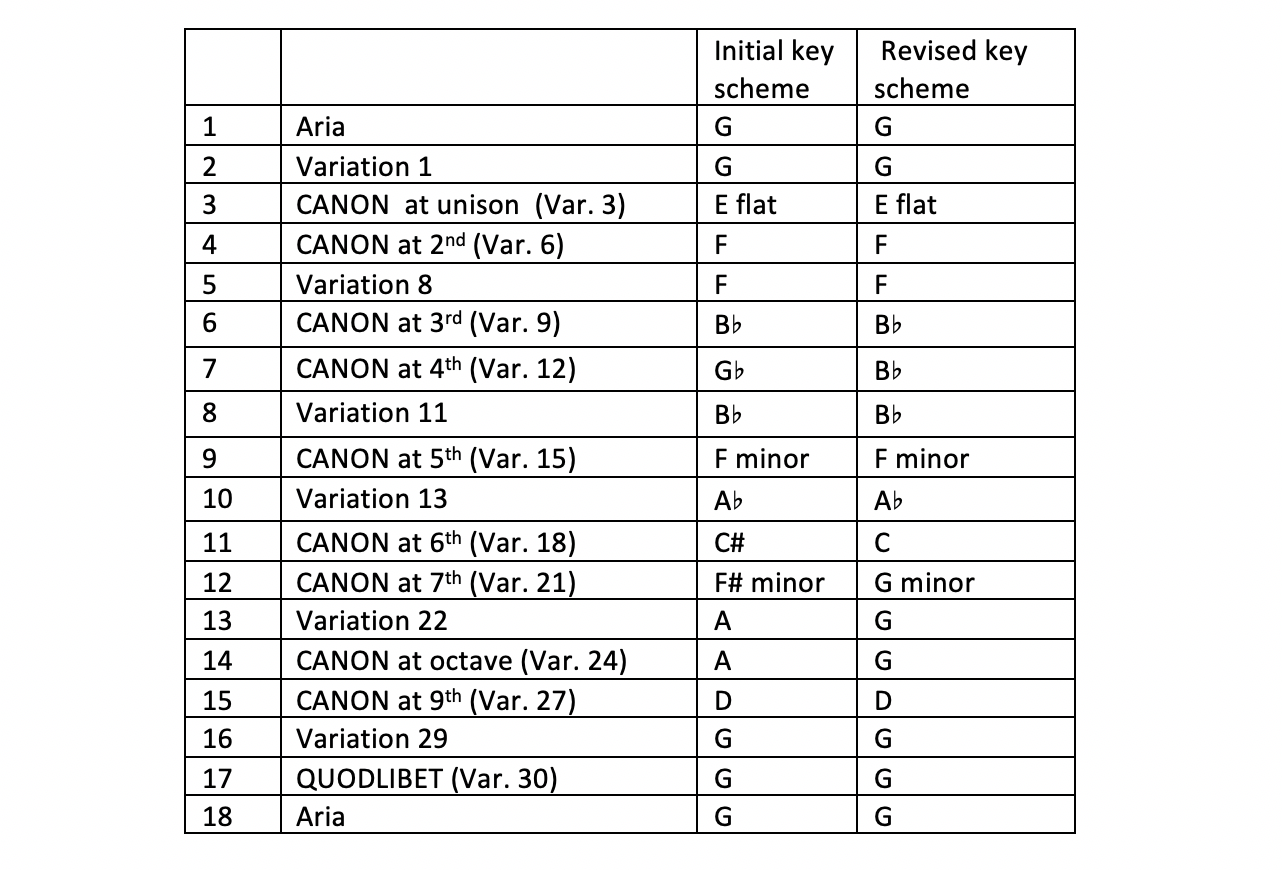
Figure 9. Initial and revised key schemes
The humorous intentions of Bach’s Quodlibet is invariably mentioned in programme notes on the work but the humour is rarely apparent because the folk songs it cites, ones that were apparently well known in Bach’s time, are unfamiliar to modern audiences. (Moreover one might add that the piece is rarely played with any signs of humour.) And so a new version of the Quodlibet was devised for this performance in Oslo, one through which we hoped to recapture the initial intention by combining popular melodies better known to audiences today. These included Beethoven’s “Ode to Joy” theme, “Here comes the bride”, “London Bridge is falling down” and “And he shall reign for ever and ever more” from the Messiah. It was somewhat disappointing that, in the Oslo performance, no one in the audience laughed. I hope some were smiling.
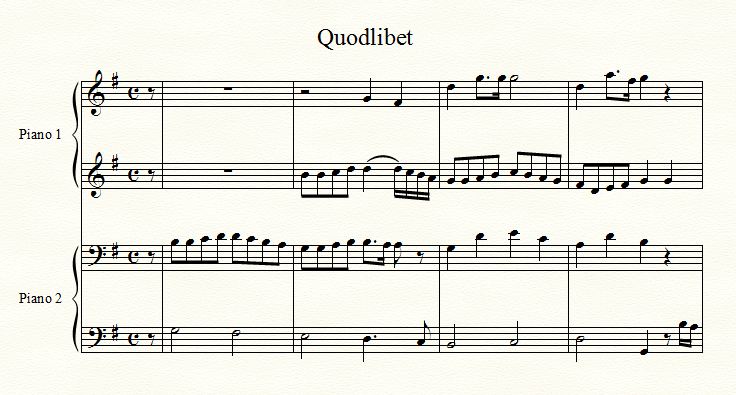
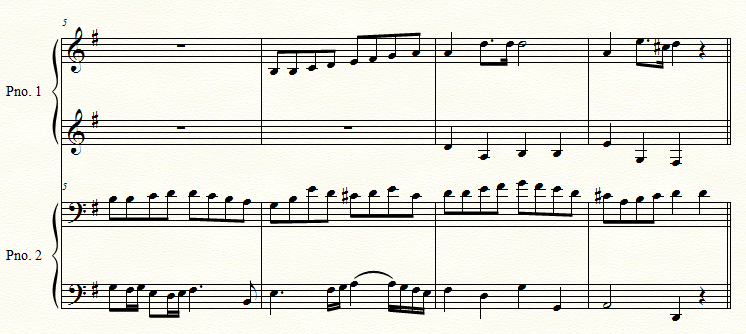
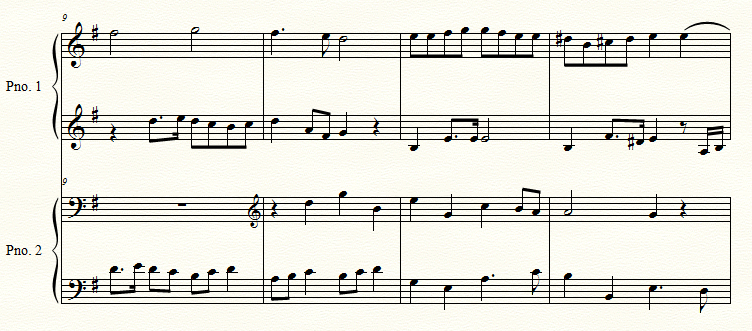
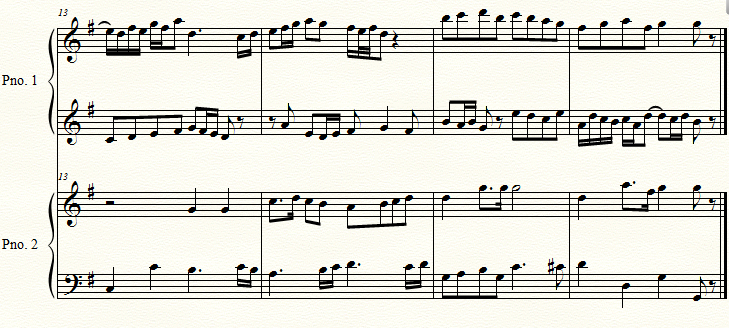
Figure 10. A new Quodlibet (devised Emmerson).
Perspective 2C (Bernard Lanskey): Balancing appreciation of ideal and actual dimensions - Implications for realisation in performance
As shared earlier, opportunities for the two of us to rehearse together are relatively rare. Our planning for this and other projects took place over some phone calls and emails across several months. As an example, while we had toyed with the above changes amongst others in our penultimate Brisbane rehearsal (helped also by the immediacy for transposition made possible by contemporary notation programs), the final scheme only emerged after I was back in Singapore. Although as collaborative pianists, we are both accustomed to tight rehearsal schedules with international partners, neither of us (except very occasionally with isolated songs for singers) had worked in a context where the tonality for the performance material was still in a state of such flux.
Adding to the challenge, it became increasingly apparent that there would be very little time for us to rehearse together for the Oslo performance in Norway itself, as Stephen could not arrive there until the day before because of another performance commitment in Australia. Under such circumstances, keeping all the variations in G – as we had played them before - would have been sensible. Had we done so the performance itself would undoubtedly been more polished but, we believe, less interesting and challenging for us. As we were keen to take advantage of the opportunities and embraced the challenges raised, we were drawn to the more adventurous alternative of the modulating version, even though it entailed considerable additional risk. However, the need to keep both versions as a possibility (with their different fingering combinations) meant the ‘final’ rehearsal had, inbuilt in it, much less of a sense of ‘fixing’ than would normally be the case.
How did such an approach to risk or experimentation in performance manifest itself as different from our more normal practice? As most readers can probably empathize, performing a shortened version with fresh changes of key affects not only how the music is heard but also how we play it. At a more philosophical or idealistic level, we continued consciously to embrace a sense of responsiveness, even playfulness, referred to in our 2016 article (Lanskey & Emmerson, 2016) so that, rather than attempting to mirror each other interpretatively, we deliberately left many variables ‘unfixed’. Hence, more subtle interpretative choices in articulation, ornamentation, dynamics, tempo (including even tempi relationships between successive variations) and phrasing could be more spontaneously responsive to acoustic, imagination, instrument or ambience.
More pragmatically, however, the multiplicity of possibilities left unfixed in a context of such limited rehearsal time unquestionably added also some psychological tension. This manifested itself most clearly in some moments of cognitive dissonance so that, in what was unquestionably an uneven performance, we each sensed extremes both of creative freedom and of restriction, often in rapid juxtaposition. Cognitively, it was almost as if ‘flow’ and ‘fear’ states were feeding off each other leaving memory traces of moments of strong freedom and connection but also of uncertainty and doubt[11].
There is of course insufficient space here to unpack such complexity in too much detail. Instead, I wish to focus here on the intriguing balance of excitement and discomfort experienced at the point of variation change. The space between variations is something we touched on above and in a previous article (2016) but, in the realisation in Oslo, the timing involved in evolving continuity between successive variations had not only to be rethought but, perhaps even more importantly, to be re-experienced.
What I found most fascinating in projecting the diversity of moments which herald each variation was the complex internal (and shared) questioning involved in crafting experiences which are essentially meaningful un-notated silences. As shared in Lanskey & Emmerson (2016), the proportion of time taken in performance in the Goldberg Variations for such silence is actually considerable. The time involved fulfils multiple roles, even before pragmatic considerations come into play: releasing the previous idea, preparing for the following, and offering also a suitable frame or connecting point for the two. Finally, the timing also influences appreciation of larger concepts of form. In the Oslo manifestation, even at the ideal this was already complex for players and audience alike: for the audience, the anticipation of what might or might not be included next - and in which key - would have been possible consideration for those who knew the work well; for the players, the relative freshness of the final choices left in fact a not dissimilar, if considerably more uncomfortable, sense of questioning.
That such so many questions might emerge even from consideration of the work’s necessary silences offers hopefully some insight into the complexity underpinning our approach to this particular performance. Whatever the degree of stress involved in the performative moment, however, its resonances afterwards have been such as to drive us as a duo towards quite fundamental reconsideration of approaches to repertoire, attitude to performance, and even choice of instrument so that the sense of experimentation is even more vividly conveyed to the listener. While this performance was arguably too risky in its realisation (translating from a performative perspective perhaps to have been not risky enough for the listener[12]), it has led to a clear ambition to design future performances built consciously around principles of embracing risk rather than comfortable assurance.
3. Preliminary Conclusions and Future Directions
The issue from a performative perspective of playing with risk is ultimately one of the principal reasons for creating this paper. For most of our professional lives as pianists, the nature of practice, beyond providing interpretative insight, has arguably been to increase assurance rather than for evolving a sense of preparedness for performative risk. Underpinning this is a tacit desire to represent, through performance, as idealised a presentation as possible of what might traditionally have been perceived as embedded musical ideas. In other words, one could argue that previously we were looking to ‘play’ a work rather than ‘play with’ that work. While such idealisation - to transmit in a single performance all or even much of what we had imagined - is of course ultimately unrealisable, there is no question that such an ambition has always acted as a powerful stimulus. Suddenly in this project (and actually in most of those associated subsequently) was a desire to represent momentary adventure and risk rather than something more assuredly formed.
This is not intended as a criticism of more traditional approaches – it is very likely that ‘recreative’ rather than ‘experimental’ ones will remain the norm – so much as an increased recognition from this project that the excitement of being on edge, more explicitly valued in truth in performative approaches typical of many other musical genres beyond Classical Western Music, must also have been part of the classical performance world, particularly where musical material for first performance was only finalised very late in the process. In such contexts, as in ours, the performance experience is brought further to the foreground of the audience experience, particularly when the musical material itself is also no longer being experienced as the re-presentation of a pre-formed recognisable ‘product’. Taking the concepts from Cook (2018) or D’Errico (2018), both cited above, our emphasis, already philosophically oriented towards ‘creative’ or ‘experimental’, found itself on this occasion being matched by practical necessity. The important element to reflect here was that this sense of danger was in fact a tremendous source of positive stimulus rather than of negative fear.
Building out from this, the influence of context in relation to the performative moment was also brought to the foreground with this project. Being on stage in what in traditional circumstances was a less than ideal situation (in terms of preparedness, duration, representational opportunity for the original piece) is in fact not such an uncommon reality for performers, even if in fact such reality is rather too little reflected in written accounts.
The balance of risk and risk management, in relation to their influence on performance flow, is only just beginning to be explored in performance literature but we believe it is something worthy of greater consideration. Importantly in this respect, even with a comparatively high degree of misjudgements and mishaps, there were sufficient compensations from such an approach that we look forward to continuing to experiment in similar directions: even in this sense alone, the formative/transformative dimensions of this particular performance would have been, for us at least, worthy of this more detailed reflection and articulation.
Reference list
Cook, N. (2018). Music as creative practice. New York: Oxford University Press.
Crispin, D. & Gilmore, B. (eds.) (2014). Artistic experimentation in music: An anthology. Leuven, Belgium: Leuven University Press.
Denk, J. (2012). Why I hate the Goldberg variations at http://www.npr.org/blogs/deceptivecadence/2012/03/16/148769794/why-i-hate-the-goldberg-variations.
D’Errico, L. (2018). Powers of divergence: An experimental approach to music performance. Leuven, Belgium: Leuven University Press.
Emmerson. S. (2017). Re-imagining Bach’s Goldberg variations*.* In Here and now: Artistic research in Music: An Australian perspective. eBook: Intelligent arts.
Hoffmann, E.T.A. (1814/1960) Fantasie- und Nachtstücke , ed. Walter Muller-Seidel. Munich.
Huron D. (2006). Sweet anticipation: Music and the psychology of expectation. Cambridge, Mass: The MIT Press.
Gotlieb, H. & Konecni, V. (1985). The effects of instrumentation, playing style, and structure in the Goldberg Variations by Johann Sebastian Bach. In Music Perception; Fall 1985; Vol.3, no.1 (pp. 87-102).
Keller, H. (1964). On variations. In The Musical Times Vol. 105. No.1452. (pp.109-111). http://www.jstor.org/sstable/951223
Lanskey, B. & Emmerson, S. (2016). Playing with variables: Some mathemusical reflections on one particular performance of Bach’s Goldberg Variations. InMathemusical conversations: Mathematics and computation in music performance and composition. London: Imperial College Press (pp. 129-152).
Martens, P. (2004). Glenn Gould’s ‘constant rhythmic reference point’: Performing and hearing pulse in Bach’s Goldberg Variations, 1955 and 1981. In voiceExchange, Volume 1.
Rosen, C. (2012). Freedom and the arts: Essays on music and literature. Cambridge: Harvard University Press.
Schenkman, W. (1975). The establishment of tempo in Bach’s Goldberg Variations. In
Bach, Vol. 6, No. 3 (July, 1975), pp. 3-10.
Steblin, R. (2002). A history of key characteristics in the eighteenth and early nineteenth centuries. 2^nd^ Ed. Rochester, N.Y.: University of Rochester Press.
Williams, P. (2001). Bach: The Goldberg Variations. Cambridge: Cambridge University Press.
-
These included performances/presentations at the Australian Piano Duo Festival (2012), the Australian Piano Pedagogy Conference in Toowoomba (2013), The Performer’s Voice Symposium in Singapore (2013) and the Performance Studies Network conference in Cambridge, UK (2014). ↩︎
-
This spontaneity, conceptualised in terms of variables, was discussed at length in our 2016 article. ↩︎
-
To quote Denk (2012) again, “three out of thirty is not many—not enough.” ↩︎
-
That project, titled To bE, involved connecting a selection of piano pieces (or extracts from them) that share the key of either E Major or B minor by a dozen different composer of the 18th and 19th centuries. The pieces were linked into a continuous hour-long ‘contemplation’ that was complemented by projected quotations from a range of theorists that described the affects of those two contrasting keys in various evocative terms. ↩︎
-
Perceptions of its inordinate length are reflected in one of E.T.A. Hoffman’s stories in Kreisleriana (1814) where Kapellmeister Kreisler plays them to an audience most of whom either leave the hall or are fast asleep by the end. ↩︎
-
Steblin (2002) cites Matheson’s description (1713) of F# minor as “although it leads to great distress, nevertheless is more languid and love-sick than lethal. Moreover it has something abandoned, singular and misanthropic about it”. (p. 268) ↩︎
-
As also cited in Steblin (2002), Matheson claims that F minor “appears to be mild and calm, yet at the same time deep and heavy with despair. It represents a fatal anxiety and is exceedingly moving.” (p. 262) ↩︎
-
This paradigm of experimentation has been adopted by artistic researchers at the Orpheus Institute and its case argued by publications such as Crispin & Gilmore (2014) and D’Errico (2018). ↩︎
-
This issue of the number symbolism in Bach’s original plan was outlined in Williams (2001) and was discussed in our previous 2016 paper. ↩︎
-
The rationale for adding extra counterpoint elsewhere to Bach’s variations is discussed in my 2014/2017 paper. ↩︎
-
Many of these ideas draw from David Huron’s Sweet Anticipation: Music and the Psychology of Expectation (2006), summarized in particular pp. 358-370. ↩︎
-
In this respect, we were grateful for some extremely pertinent and honest feedback from the well respected and insightful Liv Glaser (from the Norwegian Academy of Music) that, given the evident provocative potential, the outcome of our Oslo performance seemed in comparison relatively cautious. ↩︎